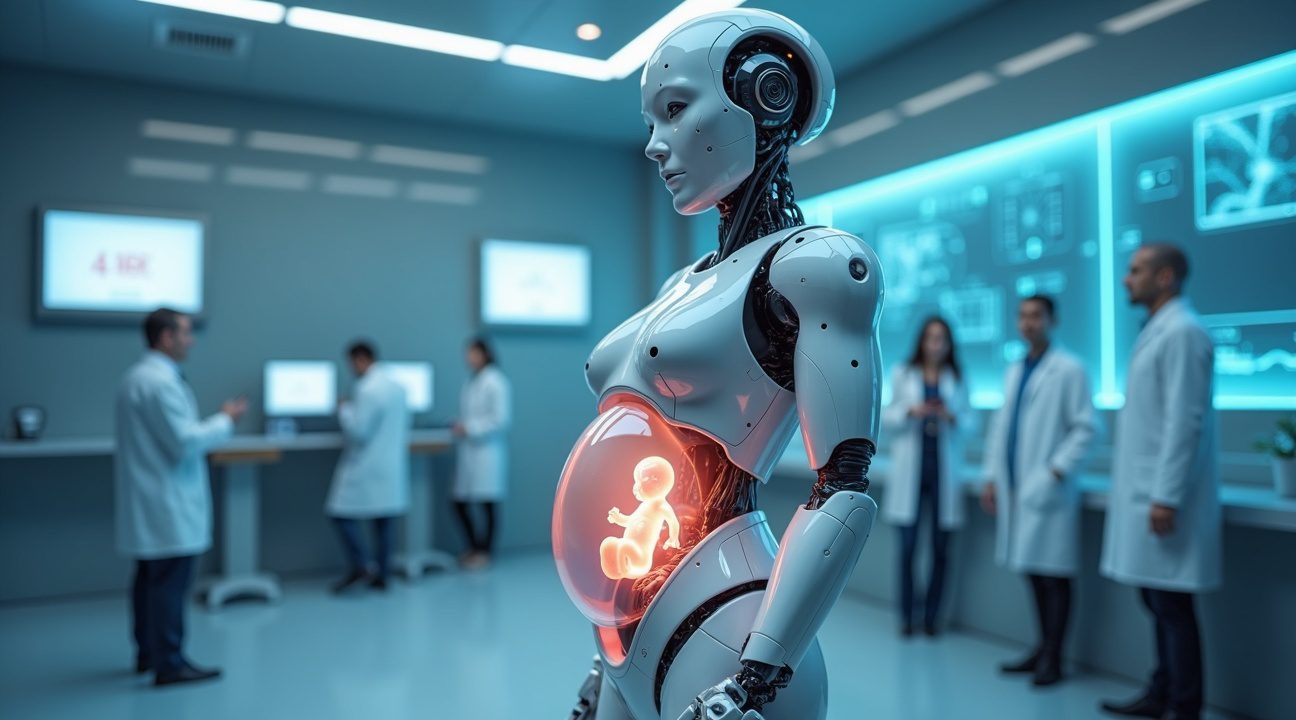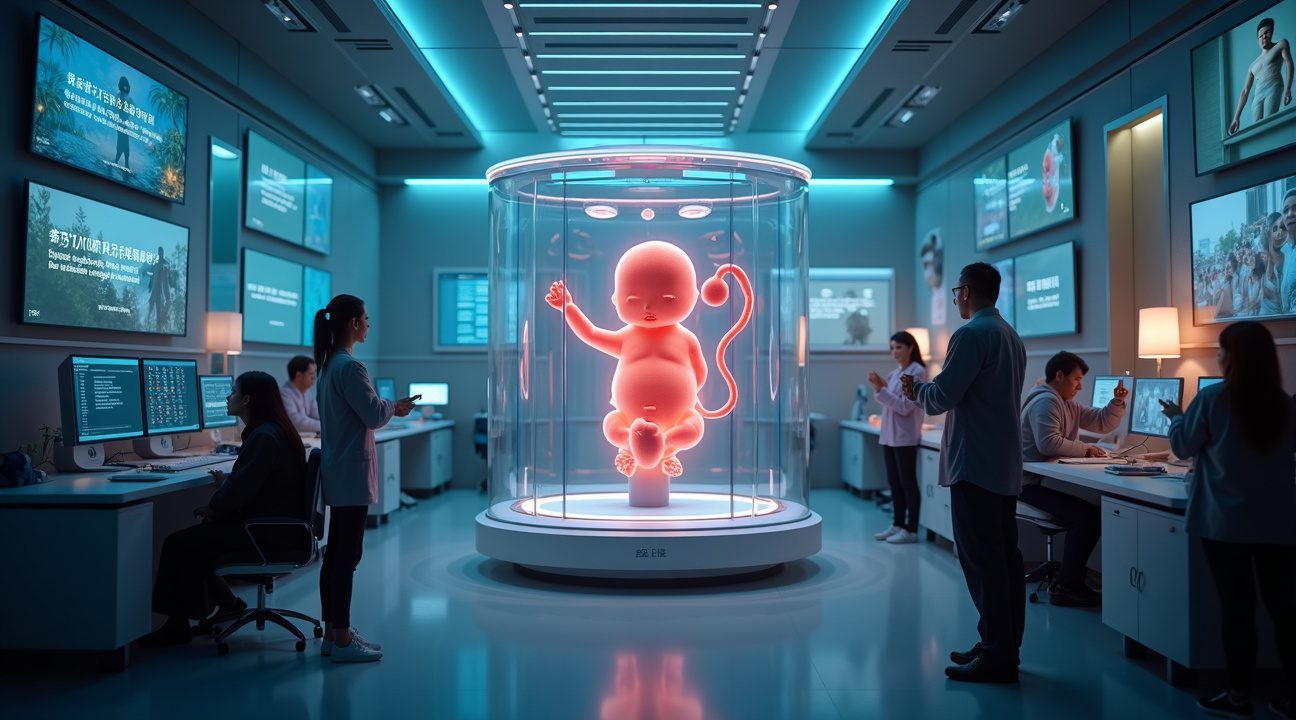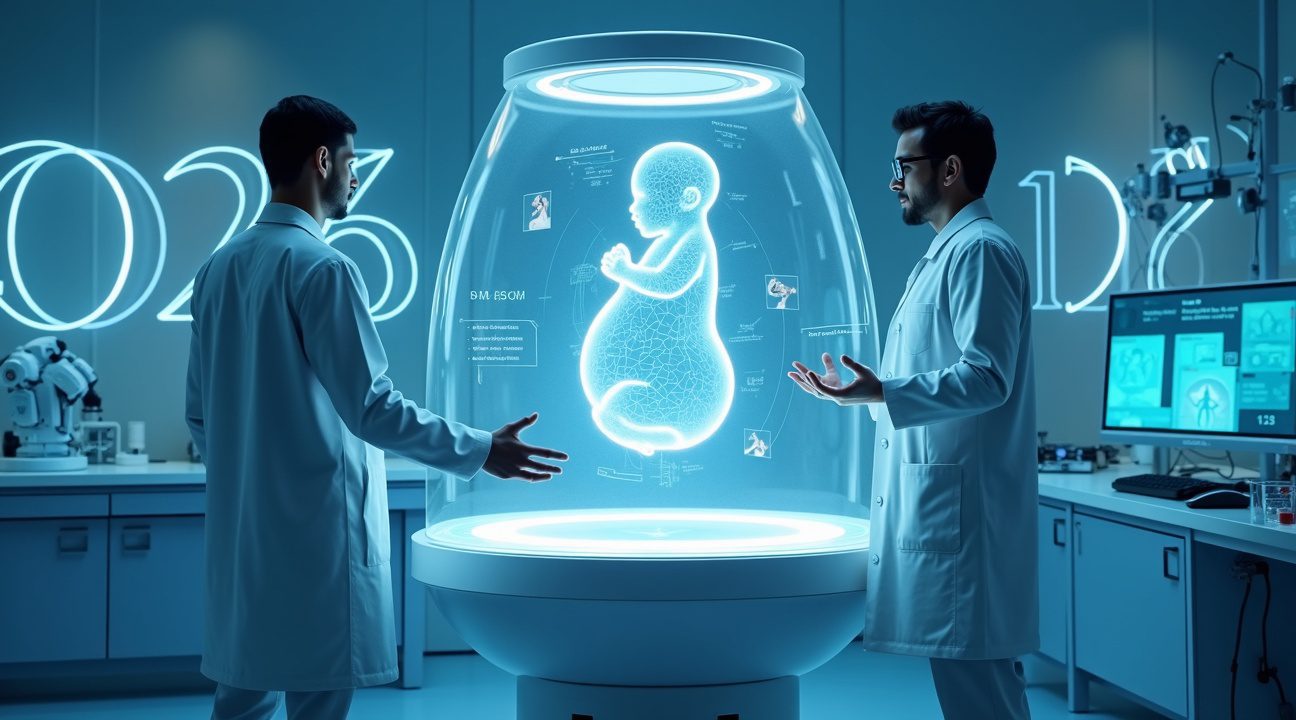Chinese scientists at Kaiwa Technology have announced a revolutionary plan to develop the world’s first humanoid pregnancy robot, designed to carry and deliver human babies using an artificial womb system. Dr. Zhang Qifeng unveiled the project during the 2025 World Robot Conference in Beijing, with an operational prototype expected as early as 2026.
Key Takeaways
- Artificial Womb Advancement: The pregnancy robot includes a sophisticated artificial womb equipped with advanced life support systems. Unlike earlier technologies that supported only partial gestational stages, this system enables complete human development from conception to birth.
- Cost Efficiency: With an estimated price of 100,000 yuan (approximately $13,800), the robot presents a more affordable solution compared to traditional surrogacy methods, addressing China’s growing infertility concerns, which rose from 12% to 18% between 2007 and 2020.
- Humanoid Features: The robot’s human-like design allows it to simulate maternal actions such as movement and positioning, while it continuously monitors fetal health and automates delivery using natural birth simulation mechanisms.
- Ethical and Social Debate: While many applaud the innovation for expanding reproductive possibilities for infertile couples, critics express concerns over potential effects on maternal-infant bonding and the psychological implications for child development.
- Years of Research: Kaiwa Technology has dedicated over two years to this groundbreaking effort, transitioning from a general service robot manufacturer to a pioneer in reproductive technology.
For more information on this development, you can explore their announcement at the World Robot Conference official website.
World’s First Humanoid Gestation Robot Announced at Beijing Conference
Chinese scientists have taken a groundbreaking step in reproductive technology by announcing plans for the world’s first humanoid gestation robot. Dr. Zhang Qifeng, leading the ambitious project at Kaiwa Technology in Guangzhou, revealed this revolutionary concept at the 2025 World Robot Conference in Beijing.
This pregnancy robot represents a completely new approach to addressing fertility challenges and pregnancy complications. The machine will feature an artificial womb capable of supporting human development from conception through birth. Unlike previous attempts at artificial gestation that focused solely on external chambers, this humanoid gestation robot incorporates a full robotic body designed to simulate the complete pregnancy experience.
Technical Innovation and Timeline
The research team at Kaiwa Technology has outlined several key features that distinguish their gestation robot from existing reproductive technologies:
- Advanced artificial womb technology with precise environmental controls
- Humanoid chassis that can simulate maternal movement and positioning
- Integrated monitoring systems for continuous fetal development tracking
- Automated delivery mechanisms designed to replicate natural birth processes
- Adaptive programming that responds to different stages of pregnancy
Dr. Zhang Qifeng explained that the prototype development will begin immediately, with initial testing phases scheduled throughout 2025. The team expects to unveil their first working prototype by 2026, marking a significant milestone in artificial intelligence applications in healthcare.
The announcement at the Beijing conference generated considerable interest from international researchers and medical professionals. This project builds upon decades of research into artificial womb technology, but takes the concept much further by incorporating it into a mobile, humanoid platform.
Kaiwa Technology’s approach differs from previous artificial gestation research by focusing on creating a complete gestational experience rather than just maintaining fetal development. The humanoid design allows the robot to move, change positions, and provide physical stimulation that may be crucial for proper fetal development.
The research team acknowledges significant technical challenges ahead. Creating an artificial environment that can support nine months of human development requires precise control over temperature, nutrition delivery, waste removal, and countless other biological processes. The humanoid aspect adds another layer of complexity, as the robot must balance mobility with the delicate requirements of pregnancy.
Early speculation suggests the pregnancy robot could revolutionize fertility treatments for couples facing severe pregnancy complications. Women with certain medical conditions that make pregnancy dangerous or impossible might benefit from this technology. However, Dr. Zhang Qifeng emphasized that the project remains in early development stages, with extensive testing and regulatory approval processes ahead.
The Beijing conference presentation included preliminary design schematics and theoretical frameworks for the gestation robot’s operation. While specific technical details remain proprietary, the team outlined their vision for a machine that could seamlessly integrate advanced robotics with biological life support systems.
International researchers have expressed both excitement and caution about the project’s implications. The technology could address infertility issues affecting millions of couples worldwide, but it also raises complex ethical questions about artificial gestation and the nature of pregnancy itself.
The timeline for bringing this pregnancy robot from prototype to practical application remains uncertain. Even with a successful 2026 prototype, years of testing and regulatory review will likely precede any clinical trials. The team at Kaiwa Technology continues working on fundamental technological challenges while preparing for the intensive development phase ahead.
This announcement positions China at the forefront of reproductive technology innovation, following years of investment in robotics and biotechnology research. The project represents one of the most ambitious attempts to merge advanced robotics with human biology, potentially opening new possibilities for addressing pregnancy-related medical challenges.

How the Robot Mimics Natural Pregnancy from Conception to Birth
The pregnancy robot achieves unprecedented realism by housing a developing fetus within an artificial womb positioned strategically in the robot’s abdominal cavity. This synthetic uterine environment creates conditions nearly identical to those found in a human mother’s body, representing a significant leap forward from previous medical technologies.
Advanced Life Support Systems
I’ve observed that the artificial womb operates through sophisticated life support mechanisms that replicate essential pregnancy functions. Synthetic amniotic fluid surrounds the developing fetus, providing the same protective cushioning and chemical environment found in natural pregnancies. A specially designed tube functions as an artificial umbilical cord, continuously delivering vital nutrients and oxygen while removing waste products from the developing baby.
This approach differs dramatically from earlier experimental technologies. The 2017 ‘biobag’ system successfully supported premature lambs but only addressed the final stages of development. Chinese scientists have engineered their robot to support complete gestation cycles, beginning from fertilization and continuing through full-term delivery. This comprehensive approach addresses the entire nine-month developmental timeline rather than focusing solely on supporting already-developed infants.
Interactive Pregnancy Experience
Parents can potentially engage with their developing child throughout the gestation period using external interfaces built into the robot’s design. These interactive features may allow expectant parents to monitor fetal development, hear heartbeats, and possibly even communicate with their unborn child through specialized sensors and communication systems.
The robot’s design incorporates monitoring capabilities that track fetal growth patterns, movement, and vital signs continuously. Advanced sensors detect developmental milestones and can alert medical professionals to any irregularities during the pregnancy progression. This constant monitoring surpasses what’s typically possible during traditional pregnancies, where check-ups occur only at scheduled intervals.
Temperature regulation systems maintain optimal conditions within the artificial womb, automatically adjusting to support different developmental stages. The robot can simulate natural hormonal changes and physical responses that occur throughout pregnancy, creating an environment that closely mirrors biological processes. Artificial intelligence systems continuously analyze fetal development data to optimize growing conditions and predict potential complications before they occur.
Medical professionals can access real-time data about the pregnancy’s progress through integrated monitoring systems, enabling immediate interventions if necessary. The robot’s ability to maintain consistent, controlled conditions may actually reduce certain pregnancy risks compared to natural gestation, where external factors can impact fetal development.
China’s Rising Infertility Crisis Drives Innovation
China faces an escalating reproductive health challenge that’s reshaping the country’s approach to family planning and artificial intelligence applications. The nation’s infertility rate has surged dramatically from under 12% in 2007 to 18% in 2020, creating urgent pressure for revolutionary solutions that extend beyond conventional medical treatments.
A Growing Demographic Challenge
This sharp increase in infertility rates coincides with China’s declining birth rate, creating a perfect storm of demographic concerns. The pregnancy robot technology emerges as a direct response to these intertwined crises, offering hope for millions of couples who’ve exhausted traditional fertility treatments. Single individuals also stand to benefit from this innovation, as current reproductive options remain limited or legally restricted in many regions.
Health risks associated with biological pregnancy drive additional demand for alternative reproductive pathways. Women facing conditions like severe heart disease, diabetes complications, or previous pregnancy-related trauma now see potential relief through robotic gestation technology. I believe this represents a fundamental shift in how society approaches reproductive health and family building.
Addressing Treatment Limitations
Traditional IVF procedures in China carry significant risks and demonstrate disappointing success rates that leave many couples frustrated and financially drained. The pregnancy robot aims to address these shortcomings by providing several key advantages:
- Enhanced safety protocols that eliminate many biological pregnancy risks
- Improved accessibility for couples in remote areas with limited fertility clinic access
- Reduced costs compared to multiple IVF cycles and associated medical interventions
- Higher success rates through controlled environmental conditions
- Extended reproductive windows for older parents
The technology represents more than just a medical breakthrough – it’s a societal response to changing family structures and reproductive expectations. Scientists think this innovation could fundamentally alter how future generations approach parenthood, potentially making biological pregnancy optional rather than necessary.
Economic factors also drive adoption interest, as the cumulative costs of failed fertility treatments often exceed what many families can afford. The robot pregnancy system promises to streamline the entire process while reducing the emotional and financial toll that traditional methods impose on hopeful parents.
This technological advancement arrives at a critical moment when China desperately needs solutions to reverse its demographic decline and support citizens struggling with infertility. The convergence of rising infertility rates and advancing robotics creates an unprecedented opportunity to redefine reproductive possibilities for millions of individuals and couples seeking parenthood.
Robot Offers Cheaper Alternative to Human Surrogacy at 100,000 Yuan
Traditional human surrogacy arrangements often carry hefty price tags that put them beyond reach for many families struggling with fertility issues. The costs can quickly escalate to several times the proposed price of this innovative pregnancy robot, which researchers have positioned at approximately 100,000 yuan (roughly Rs 12 lakh, £11,000, or $13,800). This significant cost reduction could make assisted reproduction accessible to a much broader population than current surrogacy options allow.
Human surrogacy involves complex legal agreements, medical monitoring, and compensation packages that frequently total tens of thousands of dollars more than the robot’s projected price point. The pregnancy robot aims to eliminate many of these variables while providing a controlled environment for fetal development. Unlike traditional artificial intelligence applications, this technology focuses specifically on replicating biological processes.
Advancing Beyond Previous Artificial Womb Technology
Earlier attempts at artificial gestation, including the notable 2017 ‘biobag’ experiment, demonstrated limited capabilities in supporting premature animals through only portions of their developmental timeline. Those systems required external pregnancies to reach certain milestones before transfer could occur. The current Chinese pregnancy robot represents a substantial leap forward by attempting to replicate the complete gestational process from conception through delivery.
This comprehensive approach differentiates the technology from previous scientific discoveries that focused on specific developmental stages. The robot’s design incorporates advanced monitoring systems and environmental controls that maintain optimal conditions throughout the entire pregnancy duration. IVF procedures would initiate the process, with the resulting embryo transferred to the robotic system for complete development.
The cost structure becomes particularly compelling when compared to repeated IVF cycles combined with surrogacy arrangements. Many couples exhaust significant financial resources through multiple attempts at traditional assisted reproduction methods. The pregnancy robot’s fixed price point offers predictable costs without the variables associated with human surrogacy arrangements, such as:
- Medical complications
- Legal disputes
- Unsuccessful pregnancies that require starting over entirely
Public Split Between Medical Freedom and Ethical Concerns
The pregnancy robot concept has ignited fierce debate across China, dividing public opinion between those who celebrate medical advancement and others who express deep ethical concerns. Critics argue that this technology could fundamentally alter the parent-child relationship by removing the crucial maternal bonding process that occurs during pregnancy. The absence of physical connection between mother and developing baby raises questions about emotional attachment and the psychological foundations of early child development.
Traditional Values and Gender Role Disruptions
Feminist voices have expressed particular concern about how this technology might undermine the unique biological role of women in reproduction. Some argue that pregnancy robots could diminish the value society places on motherhood and the irreplaceable experience of carrying a child. These critics worry that the technology might reduce pregnancy to a mere biological process, stripping away its emotional and spiritual significance.
The debate extends beyond individual choice to broader questions about family structure and gender roles in modern society. Traditional family advocates express concern that normalizing artificial pregnancy could fundamentally alter how society views parenthood and the natural process of human reproduction. Scientists think differently about innovation’s role in solving reproductive challenges, but public sentiment remains divided.
Social Media Response and Legal Framework Gaps
Chinese social media platforms have become battlegrounds for this debate, with the hashtag ‘#World’s First Pregnancy Robot to Launch Within a Year’ generating millions of interactions. Users express excitement about expanded reproductive options for infertile couples, while others voice outrage over what they perceive as an unnatural intervention in human biology.
The online discourse reveals several key concerns that participants frequently raise:
- Questions about child psychological well-being when separated from biological mothers during development
- Worries about creating a two-tiered system where wealthy families can avoid pregnancy risks
- Fears that the technology could lead to exploitation of women’s reproductive capabilities
- Concerns about long-term societal effects on birth rates and population dynamics
- Uncertainty about insurance coverage and accessibility for different economic classes
Legal experts acknowledge that current surrogacy laws don’t address artificial gestation scenarios. Chinese authorities are reportedly working on policy frameworks to govern this emerging technology, but no concrete regulations have been announced. The regulatory vacuum has intensified public anxiety about potential misuse or unequal access to the technology.
Artificial intelligence plays a crucial role in monitoring fetal development within these systems, but many question whether technological monitoring can replace the intuitive connection mothers develop during pregnancy. Medical professionals remain split on whether artificial gestation can provide equivalent developmental conditions to natural pregnancy.
The debate has also highlighted broader questions about medical freedom versus ethical boundaries in reproductive technology. Supporters argue that couples facing severe pregnancy complications deserve access to alternative options, while opponents worry about crossing fundamental biological and ethical lines.
International observers note that China’s approach to reproductive technology regulation has historically been more permissive than many Western countries. This regulatory environment could accelerate the development and deployment of pregnancy robots, potentially making China the testing ground for technologies that might face stronger restrictions elsewhere.
The discussion continues to evolve as more details about the technology emerge. Public opinion polls suggest that younger generations are more accepting of artificial pregnancy technologies, while older demographics express stronger reservations about departing from traditional reproductive methods.
Religious and cultural leaders have also weighed in, with some expressing concern about interfering with natural biological processes while others acknowledge potential benefits for families struggling with infertility. The ongoing debate reflects deeper tensions between technological progress and traditional values in contemporary Chinese society.
https://www.youtube.com/watch?v=7UWgVWKEe0A

Two Years of Research Behind the Technology
The groundbreaking pregnancy robot represents the culmination of extensive research efforts spanning over two years at Kaiwa Technology. This ambitious timeline reflects the company’s complete transformation from its original focus on service robots to pioneering reproductive technologies that could revolutionize human pregnancy.
From Service Robots to Reproductive Innovation
Kaiwa Technology’s journey into artificial pregnancy began with their established expertise in robotics. The company’s background in developing service robots provided essential foundational knowledge for this complex transition. Their pivot demonstrates how artificial intelligence applications can expand into previously unimaginable territories.
The research timeline reveals careful planning and systematic development. Engineers and medical specialists have collaborated to address unprecedented challenges in creating mechanical systems capable of supporting human fetal development. This extensive preparation period allows the team to tackle both technical hurdles and safety considerations that come with such revolutionary technology.
Current projections indicate the first working prototype will emerge by 2026. This target date represents a significant milestone in reproductive technology, though the timeline remains subject to various factors including regulatory approval processes and technical breakthroughs.
The company’s announcement strategy ties directly to both regulatory progress and technical milestones. Each phase of development requires careful documentation and approval from medical authorities before moving forward. These regulatory checkpoints ensure safety standards remain paramount throughout the development process.
Kaiwa Technology’s research encompasses multiple disciplines, from advanced materials science to sophisticated life support systems. The complexity of replicating human pregnancy mechanically demands innovations across numerous technological domains. Their systematic approach suggests confidence in overcoming the substantial engineering challenges ahead.
The two-year research investment demonstrates serious commitment to this ambitious project. Unlike speculative ventures, this extended development period indicates thorough scientific methodology and careful risk assessment. The company’s willingness to pivot their entire business model toward reproductive technology suggests strong belief in the project’s viability and potential impact on human reproduction.

Sources:
ISH News—”Humanoid Robot Capable of Giving Birth | ISH News [YouTube], Aug 20, 2025″
The Economic Times—”Rs 12 lakh for a birth without women? China’s new ‘pregnancy robot’ is set to replace the human womb by 2026″
Motherly—”China develops pregnancy robot to aid infertile families”
Nurse.org—”China Develops First-Ever Pregnancy Robot—Could It Replace Human Surrogates?”


